Karin Endo, Yoko Niki, Hiroki Kotera, Kazuhiro Iwasaki, Yukihiro Ohashi
Nippon Fine Chemical Co., Ltd., Cosmetic ingredients Laboratory

About A Novel Bioactive Lipid-Ingredient, Phosphatidylinositol,
1. Introduction
We focused on phosphatidylinositol (PI) (Figure 1), a bioactive phospholipid, and developed a lipid complex, PrimeLipid PI, which contains a high content of PI. Although PI only accounts for a small (less than 10%) fraction of cellular phospholipids, it plays important roles in cell signaling, lipid signaling, and membrane trafficking. PrimeLipid PI is an easy-to-prepare liposomal preparation ingredient. It has moisturizing, anti-wrinkle, and antioxidant effects, which prevent the skin from harmful oxidation stress caused by blue light and air pollution. PrimeLipid PI is a new ingredient based on our innovative lipid technology.

2-1. PrimeLipid™ PI

PrimeLipid PI is an ingredient that allows easy preparation of stable liposomes using a homomixer (Table 1). These liposomes contain a high content of phosphatidylinositol (PI) as a key ingredient and have a multilamellar structure (Fig. 2A). PrimeLipid PI-containing lotion has high transparency and stability (Fig. 2B).

(A) Transmission Electron Microscope (TEM) image of liposome prepared from PrimeLipid PI.
(B) Photograph of the PrimeLipid PI lotion.
2-2. Moisturizing effect
PrimeLipid PI lotion (Table. 1) was applied to the medial forearm of 11 male and female subjects (25 to 45 years of age) twice daily, and skin conductance was evaluated at weeks 0, 2, and 4 (Fig. 3). As a result, the skin conductance was improved by about 2 times in comparison with the untreated area. (**P<0.01 versus no treatment.)

2-3. Anti-wrinkle effect
To examine the effect of the 0.2% PrimeLipid PI lotion (Table. 1), it was applied around one of the eyes of 18 female subjects (35 to 58 years of age) twice daily, and we found that the application improved the appearance of wrinkles on the outer corners of the eye. Representative photographs are shown in Figure 4A. The wrinkles on the outer corner of the eyes were less noticeable on the side treated with the PrimeLipid PI lotion compared to the untreated side. After 4 weeks, the wrinkle scale significantly improved the sites treated with PrimeLipid PI lotion compared with the sites without treatment (Figure 4B). Significantly different results: **P<0.01 (Wilcoxon signed-rank test).
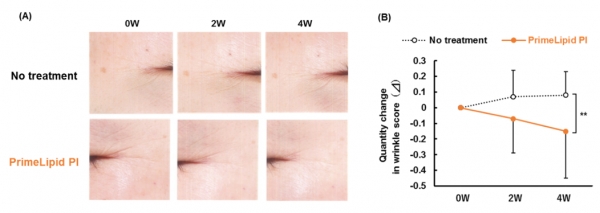
2-4. Anti-oxidation effects
Oxidative stress (reactive oxygen species [ROS]) induced by chronic exposure to sunlight is considered to be one of the causes of cosmetic skin problems such as age spots and wrinkles. The Keap1-Nrf2 (Kelch ECH associating protein 1 – Nuclear factor erythroid 2-related factor 2) system is an innate protection system of cells from the harmful effects of ROS. Nrf2, which acts as a control tower for biological defense, moves into the nucleus when cells are exposed to oxidative stress, and induces the expression of many stress-responsive genes such as CAT (catalase) and γ-GCS (γ-glutamylcysteine synthetase)1).
PrimeLipid PI reduced intracellular ROS levels (Fig. 5A, Significantly different results: **P<0.01, ***P<0.001.) by activating the Keap1-Nrf2 system. PrimeLipid PI treatment improved the nuclear translocation of Nrf2 in NHEKs (normal human epidermal keratinocytes), as observed by immunostaining (red: Nrf2, blue: nucleus, Fig. 5B). The Nrf2 and nuclear colocalization rate from the analysis of the acquired images had approximately a 2.5-fold increase in PrimeLipid PI- treated NHEKs (Fig. 5C, Significantly different results: *P<0.05.). Prime Lipid PI elevated the gene expression of CAT, which scavenges hydrogen peroxide (Fig. 5D, Significantly different results: *P<0.05, **P<0.01.). Moreover, the catalase activity in the stratum corneum harvested by tape stripping from the skin at the site where the PrimeLipid PI lotion was applied for two weeks was approximately four times the one in the untreated area (Fig. 5E, Significantly different results: *P<0.05.). These results suggest that PrimeLipid PI is expected to maintain healthy skin the skin healthy by alleviating oxidative stress.
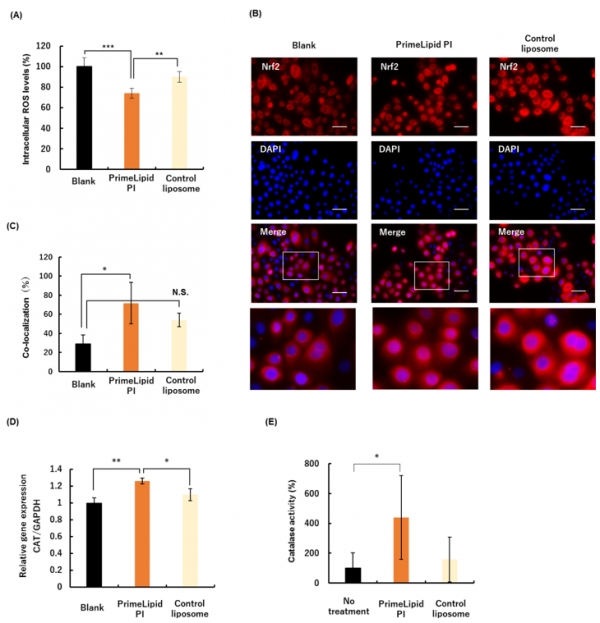
2-5. Anti-Blue light effects
UV irradiation has been mentioned as one of the main causes of skin trouble until now. However, with the popularization of smartphones and LEDs, the effect of visible light, especially blue light (380-500 nm) with strong energy, on the skin is noticed. Activation of pigment cells and increase in ROS have been reported as effects of blue light on the skin2), 3). In addition, mitochondria are strongly damaged by blue light because they have cytochrome c oxidase with an absorption peak at 440 nm and Flavin-containing oxidases with an absorption peak at 370 nm and 450 nm4), 5). Since oxidative stress and mitochondrial dysfunction are factors causing aging, blue light may induce skin aging. Therefore, it is important to prevent oxidative stress due to blue light as well as UV irradiation for skin anti-aging.
PrimeLipid PI decreased intracellular (Fig. 6A, Significantly different results: ***P<0.001.) and mitochondrial ROS levels (Fig. 6B, Significantly different results: *P<0.05, **P<0.01.) in NHEKs exposed to 45 J/cm2 of blue light. In addition, mitochondrial lipid peroxidation levels, which are caused by oxidative stress, were significantly decreased by the PrimeLipid PI treatment (Fig. 6C, Significantly different results: *P<0.05.).
Daily exposure to blue light from digital devices, such as smartphones as well as the blue light contained in sunlight, may cause skin aging. In addition to protecting the skin using products such as sunscreen, the use of ingredients that exert their effects by acting from the inside of cells, such as PrimeLipid PI, is expected to lead to a total anti-aging approach.
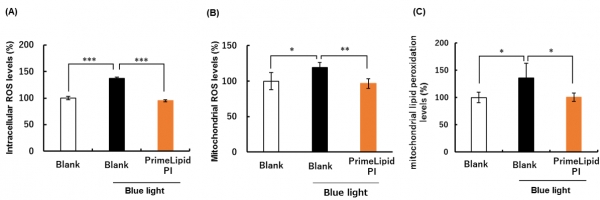
2-7. Anti-pollution effects
Air pollutants such as particulate matter (PM) induce ROS in skin cells and are one of the external environmental factors that cause skin problems6). Epidemiological studies have shown that pigment spots and wrinkles are common among people living in areas with high levels of air pollutants, suggesting a direct association with skin aging 7). We evaluated the intracellular ROS level as an index to confirm the anti-pollution effect of PrimeLipid PI using diesel particulate matter (DPM, NIST 1650b PM2. 5, Sigma-Aldrich) as air pollutants.
The human epidermal keratinocyte cell line (HaCaT) seeded in cell inserts was cultured in PrimeLipid PI-containing medium. After 24 h, HaCaT cells were co-incubated with freshly cultured HaCaT or human dermal fibroblasts (NHDFs) in the cell culture plate and exposed to DPM (200 μg/mL). After that, intracellular ROS levels in HaCaT and NHDFs, which were cultured in the cell culture plate, were evaluated (Fig. 7A). Intracellular ROS levels in HaCaT and NHDFs co-incubated with DPM-treated HaCaT cells were increased. These results indicate that PM causes oxidative stress in epidermal cells, and that this stress is transmitted to nearby keratinocytes and dermal fibroblasts. In contrast, HaCaT and NHDFs co-cultured with DPM and PrimeLipid PI-treated HaCaT cells showed no increase in intracellular ROS levels (Fig. 7B, C). PrimeLipid PI suppresses ROS in the skin cells induced by DPM and is expected to be effective anti-pollution cosmetic ingredient. Significantly different results: **P<0.01.
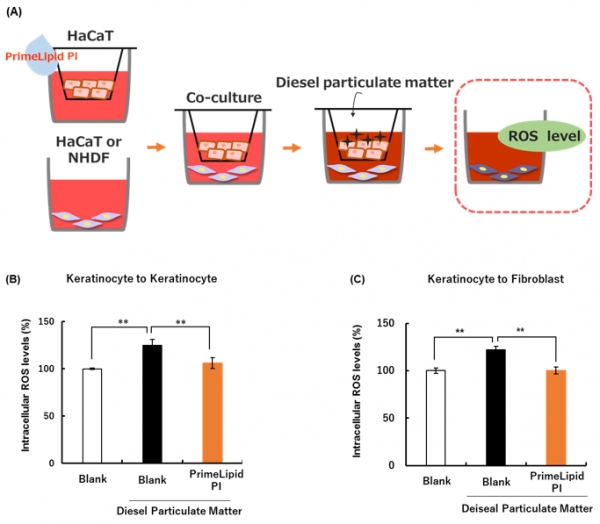
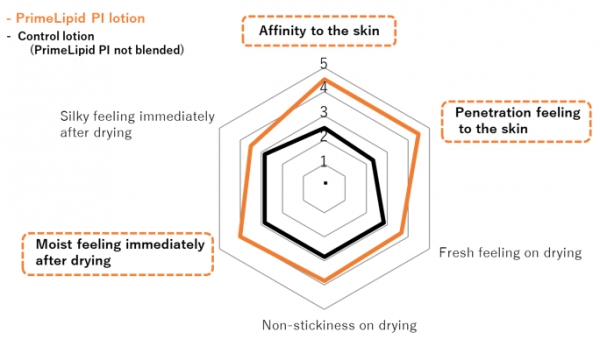
3. Conclusion
PrimeLipid PI contains high concentrations of phosphatidylinositol (PI), which is a bioactive lipid. Although reports of the effect of PI on skin physiology have been scarce, our studies show that PrimeLipid PI has moisturizing, anti-wrinkle, antioxidant, and multi-physiological activity effects. Many studies have reported that various external factors such as blue light and air pollutants cause skin troubles8). PrimeLipid PI activates Nrf2, an innate intracellular antioxidant system, and can prevent oxidative stress and skin aging. In addition, sensory evaluation tests showed that the PrimeLipid PI lotion (Table 1) improved the feeling of affinity, penetration feeling to the skin, and moist feeling immediately after drying (Fig. 8). PrimeLipid PI is a unique ingredient associated with multiple positive physiological activity effects on the skin and with good sensory feelings.
PrimeLipid™ is the registered trade mark of Nippon Fine Chemical Co., Ltd.
References
1) Hseu YC, Lo HW, Korivi M, Tsai YC, Tang MJ, Yang HL, Dermato-protective properties of ergothioneine through induction of Nrf2/ARE-mediated antioxidant genes in UVA-irradiated Human keratinocytes, Free Radic Biol Med, 86 (2015) 102-17.
2) Regazzetti C, Sormani L, Debayle D, Bernerd F, Tulic MK, De Donatis GM, Chignon-Sicard B, Rocchi S, Passeron T, Melanocytes Sense Blue Light and Regulate Pigmentation through Opsin-3, J Invest Dermatol, 138 (2018) 171-178.
3) Godley BF, Shamsi FA, Liang FQ, Jarrett SG, Davies S, Boulton M, Blue Light Induces Mitochondrial DNA Damage and Free Radical Production in Epithelial Cells, J Biol Chem, 280 (2005) 21061-21066.
4) Lubart R, Wollman Y, Friedmann H, Rochkind S, Laulicht I, Effects of visible and near-infrared lasers on cell cultures, J Photochem Photobiol B, 12 (1992) 305-310.
5) Chen E, Söderberg PG, Lindström B, Cytochrome oxidase activity in rat retina after exposure to 404 nm blue light, Curr Eye Res, 11 (1992) 825-831.
6) Morita A, Torii K, Maeda A, and Yamaguchi, Molecular basis of tobacco smoke-induced premature skin aging, J. Investig. Dermatol. Symp, 14 (2009) 53–55.
7) Airborne Particle Exposure and Extrinsic Skin Aging, Andrea Vierkötter, Tamara Schikowski, Ulrich Ranft, Dorothea Sugiri, Mary Matsui, Ursula Krömer, and Jean Krutmann, J Invest Dermatol, 130 (201) 2719–2726.
8) Krutmann J, Bouloc A, Sore G, Bernard BA, Passeron T, The skin aging exposome, J Dermatol Sci, 85(2017) 152-161.
Contact
Nippon Fine Chemical Co., Ltd.
Address: Kodenma-cho Shin Nihonbashi Building, 4-9 kodenma-cho, Nihonbashi, Chou-ku, Tokyo 103-0001
Telephone: +81-3-3664-7781
Website: http://www.nipponseika-cosme.com

